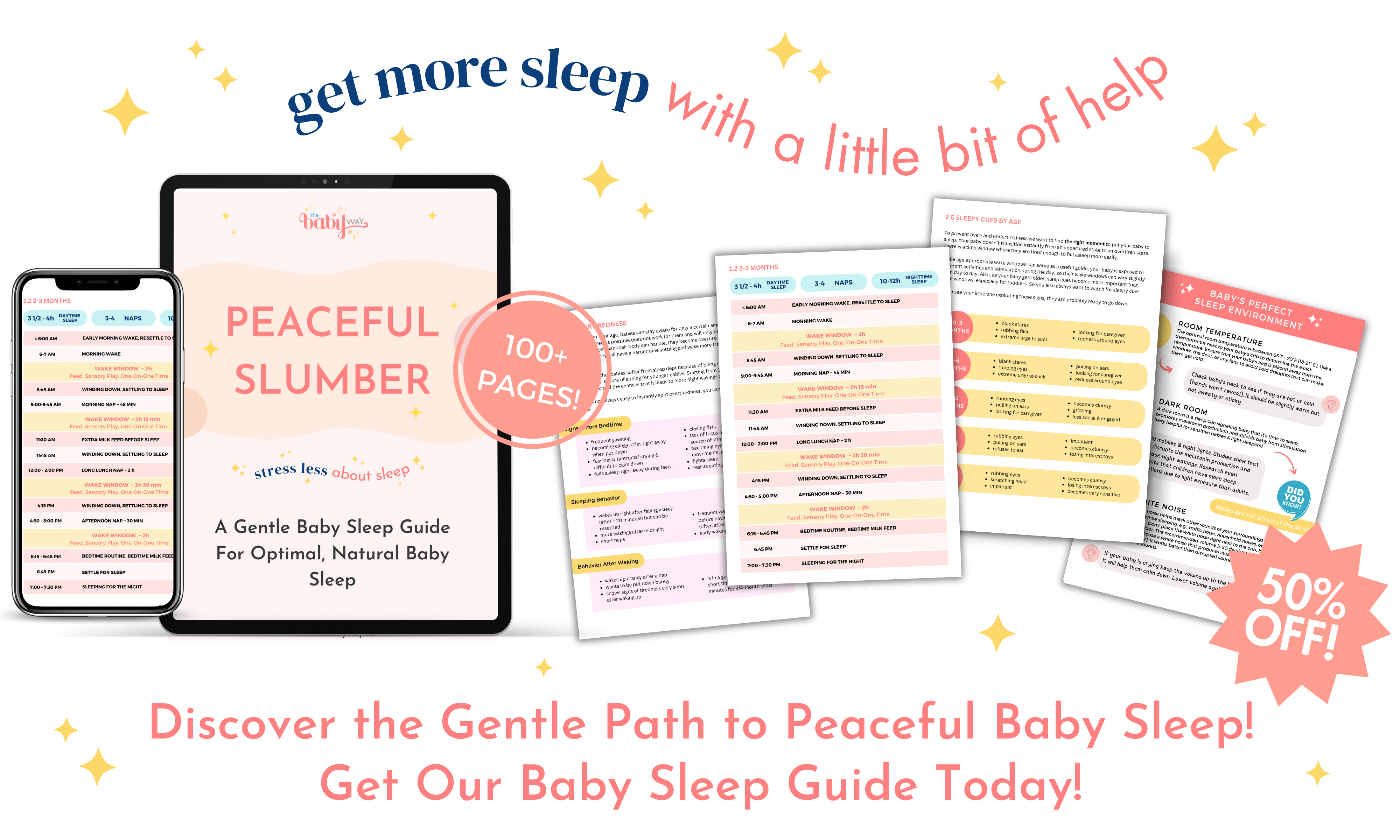Dressing baby for sleep can be a real challenge. Are they too warm? Are they too cold? Are they both? Who says it's not possible?! Determining just the right amount of clothing for your baby is not only essential for a good night's rest, but it's also crucial to guarantee safe sleep. Therefore, let's take out the guesswork once and for all and learn what baby should wear at night.
As a first-time mom, I always used to worry about my baby getting too cold or too warm at night. I would constantly check her neck, check our thermometer and adjust the room temperature.
So not only did her night feedings keep me awake, but obviously also my anxiety about over- or underdressing my baby at night (well, besides 100 other fears, but this shall not be part of this article).
And, of course, if the baby didn't sleep well, she either must have been too cold or too warm. At least, according to my husband.
But here is the thing. Figuring out what your baby should wear is not as much of a science as it turns out. And if you use one little helper, everything gets automatically easier.
And that is a sleep sack.
A sleep sack or baby sleeping bag is such a handy tool to keep your baby warm and safe without the risks of a loose blanket. In this article, we will give you an ultimate sleep sack temperature guide, helping you determine what your baby should wear for sleep.
This article covers:
-
1. Understanding Safe Sleep
2. Why Temperature Matters So Much
3. Introducing Sleep Sacks And Baby Sleep Bags
4. Choosing the Right Sleep Sack
5. Dressing Your Baby for Sleep
6. What to Do in Warmer Temperatures
7. What to Do in Colder Temperatures
8. How To Check Your Baby's Temperature
9. Other Considerations
10. FAQ
1. Understanding Safe Sleep
Before we get into the details of sleep sacks and what to wear, it's important to understand the principles of safe sleep. Safe sleep guidelines help reduce the risk of Sudden Infant Death Syndrome (SIDS) and other sleep-related deaths.
The American Academy of Pediatrics recommends that babies sleep on their backs on a firm and flat surface. Their sleep space should be free from loose bedding like blankets and pillows, and there shouldn't be any objects like stuffed animals or toys.
It is also better to wait with letting your baby sleep with a lovey or stuffed animal in the first year.
2. Why Temperature Matters So Much
The right temperature is essential for a good night's sleep for both adults and babies. A 2012 study found that the room temperature is one of the most important factors for achieving quality sleep.
But temperature matters even more for babies, not only for better quality sleep but also for safe sleep. While adults are able to regulate their inner body temperature, infants and young babies cannot regulate their body temperature until they are about 1.5-2 years old.
Therefore, overdressing your baby can lead to overheating, which increases the risk of SIDS.
3. Introducing Sleep Sacks And Baby Sleep Bags
A sleep sack or baby sleep bag is the perfect tool to keep your baby warm and safe.
With a sleep sack, not only don't you have to worry about a baby that constantly kicks off their blanket (my 5-year-old still does that, btw), but it is also a much safer alternative to a loose blanket.
Additionally, you can much easier control baby's temperature.
Sleep sacks come in a range of sizes and thicknesses to suit different room temperatures and can be worn over your little one's regular sleepwear.
4. Choosing the Right Sleep Sack
When choosing a sleep sack, it's important to consider the temperature of your baby's room. According to the room temperature, you will choose a sleep sack with the right thickness. As a general rule, the ideal temperature for your baby's room is 68-72°F (20-22.2°C).
The thickness of a sleep sack is measured in tog ratings. A higher tog indicates a warmer sack. You will probably not use the same sleep sack for the whole year. Therefore it can be helpful to have at least two sleep sacks with different tog levels (one for the summer and one for the winter).
Here is a sleep sack temperature guide for different room temperatures:
- Room temperature of 75°F (24°C) or higher: 0.5 tog sleep sack
- Room temperature of 69-74°F (21-23°C): 1.0 tog sleep sack
- Room temperature of 54-68°F (12-20°C): 2.5 tog sleep sack

5. Dressing Your Baby for Sleep
Once you have chosen the appropriate sleep sack, you can dress your baby accordingly. In general, a onesie or a body is all that is needed underneath the sleep sack.

Here are some additional tips for dressing your baby for sleep:
- Avoid dressing your baby in too many layers, which can cause overheating.
- Make sure your baby's head and neck are uncovered.
- Check your baby's temperature by feeling their neck, not their hands or feet.
- If your baby is sweating or their skin feels hot to the touch, they may be too warm.
- If you are bed-sharing, it is not recommended to use a sleep sack.
6. What to Do in Warmer Temperatures
During hot summer nights, it can be challenging to keep your baby comfortable, especially if you don't have air conditioning available. Here are some tips for dressing your baby in warmer temperatures:
- Choose a lightweight sleep sack with a low tog rating, such as 0.5 tog.
- Dress your baby in a short-sleeved onesie or a sleeveless sleep suit.
- Keep the room cool by using a fan or air conditioning (but keep baby away from direct blast of cold air).
7. What to Do in a Colder Temperatures
When the temperature drops, it's important to keep your baby warm and cozy. Here are some tips for dressing your baby in colder temperatures:
- Choose a sleep sack with a higher tog rating, such as 2.5 tog.
- Dress your baby in a long-sleeved onesie or sleep suit.
- Consider layering with a onesie and pajamas for extra warmth.
8. How To Check Your Baby's Temperature
If you're like me, you will probably check your baby's temperature a couple of times at night. Yay!
Here are some tips on how to check your baby's temperature:
- Feel your baby's neck to check for their temperature. Their neck should be warm but not sticky.
- Use a room thermometer to monitor the temperature of the room.
- Check your baby's temperature if they are unwell or seem uncomfortable.
- A general rule of thumb is that a newborn should wear one more layer of clothing than you.
9. Other Considerations
When dressing your baby for sleep, there are some other considerations to keep in mind. Here are a few additional tips:
- Consider the fabric of your baby's sleepwear. Natural fibers like cotton and bamboo are breathable and comfortable.
- Make sure the sleep sack fits well and is not too loose as it can cover their face.
- Avoid using blankets or other loose bedding in your baby's sleep environment.
10. FAQ
What is a sleep sack?
A sleep sack is a wearable blanket designed to keep your baby warm without the need for loose blankets.
How do I choose the right sleep sack for my baby?
Choose a sleep sack with a tog rating appropriate for the temperature of your baby's room. Refer to the guide in this article for more information.
What should my baby wear under a sleep sack?
In general, a onesie or sleepwear is all that is needed underneath a sleep sack. Refer to the tips in this article for more detailed information.
Can my baby overheat in a sleep sack?
Yes, it's important not to overdress your baby. Refer to the tips in this article for more information on monitoring your baby's temperature.
Is it safe to use a sleep sack?
Yes, sleep sacks are a safe alternative to loose blankets, which can increase the risk of SIDS if they become loose and cover the baby's face.
How long can my baby or toddler wear a sleep sack?
There is really no age limit. Many toddlers and even preschoolers still kick off their blankets. When using a sleep sack for an older child, you should only make sure that it's long enough. You can also look for sleep sacks with separate legs or footed pajamas.








